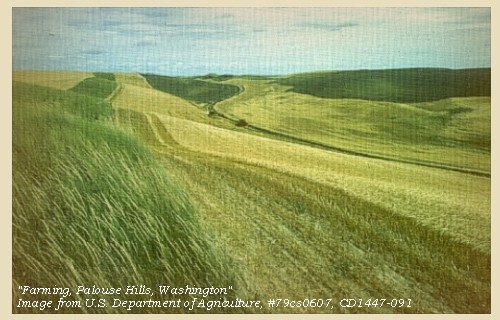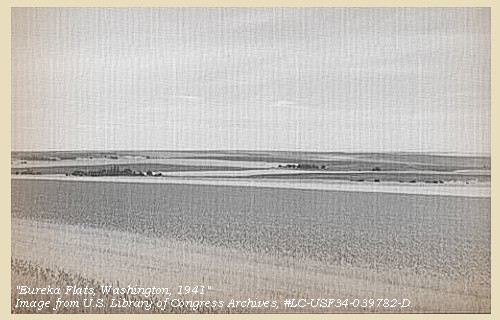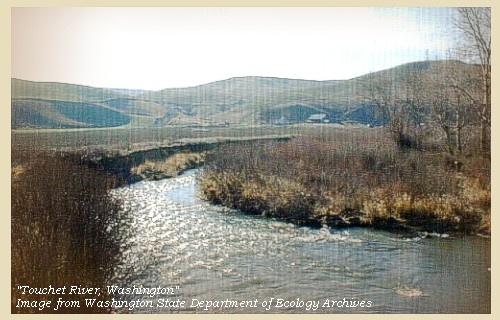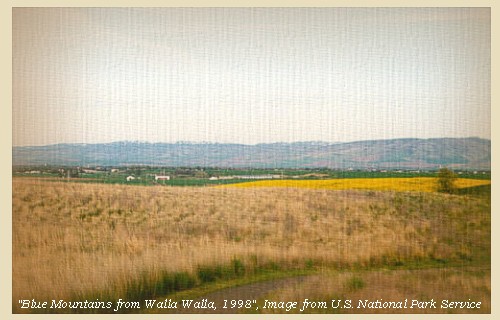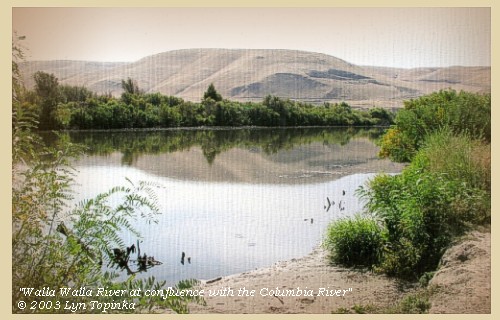
Walla Walla River:
The Walla Walla River basin lies between the Snake River basin on the north, the Blue Mountains to the east and south, and the Umatilla River basin on the south and west.
The basin includes parts of Walla Walla and Columbia counties in Washington and part of Umatilla County in Oregon, and covers 1,720 square miles. The basin is approximately 55 miles long by 52 miles wide, with elevations ranging from a high of 6,250 feet to a low of 340 feet. It is located near the boundary between the Blue Mountains (south and southeast) and Columbia River Plateau (north and northwest) physiographic regions. Regional folding around the basin boundary and faulting formed the Walla Walla basin. The major rock underlying the basin is the Miocene Age (15 to 20 million years ago) Columbia River Basalt Group, which consists of a thick sequence of lava flows known to be in excess of 6,000 feet thick near Pasco. Individual flows generally range from approximately 50 to over 150 feet. Unconsolidated gravels and clays overlie the basalt. An extensive deposit of windblown silt (loess soil) called the Palouse Formation covers most of the Walla Walla River basin. This formation eroded and resulted in the gently rolling hills that are typical of the region.
The Walla Walla River itself originates in the northeast corner of Umatilla County in Oregon. It dips south from there and then flows north through Milton-Freewater, crossing the Oregon/Washington border 6 miles north of Milton-Freewater.
The principle tributaries of the Walla Walla include the Touchet River, Mill Creek, and the North and South Forks of the Walla Walla River.
-- U.S. Army Corps of Engineers Website, 2004, Walla Walla District,
Washington State Department of Ecology Website, 2004, and
Columbia Basin Fish and Wildlife Authority Website, 2004













- 1814 Map, Lewis and Clark's map of the Columbia River (section of original). (Click to enlarge.) Shows the Walla Walla River ("Wollawwollah R.").
Map also includes three of the five volcanoes Lewis and Clark saw and commented on. While the journals mention the expedition seeing Mount Adams, it does not appear on their map. Mount Jefferson is just visible to the south (bottom) and Mount Rainier is to the north but off the map.
From the "Nicholas Biddle/Paul Allen" 1814 publication.
Original Map: "A Map of Lewis and Clark's Track, Across the Western Portion of North America, From the Mississippi to the Pacific Ocean".
From: History of the expedition under the command of Captains Lewis and Clark : to the sources of the Missouri, thence across the Rocky Mountains and down the river Columbia to the Pacific Ocean : performed during the years 1804-5-6 : by order of the government of the United States / prepared for the press by Paul Allen. Philadelphia : Bradford and Insskeep, 1814.
Harold B. Lee Library, Brigham Young University #upbover maps37.
-- Brigham Young University, Harold B. Lee Library Website, 2004.
- 1833 Map (section of original), Columbia River. (Click to enlarge).
Includes Mount Hood and Mount Jefferson. Note: Mount Baker is depicted (upper middle) but Mounts Adams, Rainier and St. Helens are missing. The Columbia River is shown as "Oregon River" at its mouth and "Columbia or Oregon R." further inland. "Wappatoo Valley" is labeled. Also shows Fort Clatsop ("F. Clatsop or F. George"), the Willamette River ("Multnomah R."), Sandy River ("Quicksand R."), John Day River ("R.La Page"), Walla Walla River ("Wallwullah R."), Snake River ("Lewis R."), and the Yakima River ("Tapete R.").
Original Map: Oregon Territory, 1833.
Creator: Illman & Pilbrow, published by Illman & Pilbrow, New York.
Comments: Illman & Pilbrow is the engraving firm which copyrighted and published this map, the actual artist is unknown.
Washington State University Digital Maps Collection #WSU323.
University of Washington Digital Maps Collection #UW104.
-- Washington State University Early Washington Maps Digital Collection Website, 2004
- 1853 Map, Washington and Oregon and the Columbia River,
from the Clearwater River to the Snake River and down the Columbia River to the Pacific Ocean (section of original). (Click to enlarge).
Includes: Clearwater River (Kooskooski), Lapwai Creek (Lapwai R.), Snake River (Saptin or Lewis R.), Columbia River (Columbia R.), Yakima River (Yakima R.), Walla Walla River (Wallawalla R.), Umatilla River (Umatilla R.), Willow Creek (Quesnells R.), John Day River (John day's R.), Deschutes River (Fall R.), Willamette River (Willammette R.), and Cowlitz River (Cowlitz R.).
Original Map: "Map of California, Oregon, Washington, Utah, and New Mexico (1853)",
by Thomas Cowperthwait & Co.
Washington State University Archives #WSU22.
-- Washington State University Library Collections Website, 2003
- 1853-54 Map, Columbia River, including the Wallula Gap area (section of original). (Click to enlarge).
Includes Horse Heaven Hills ("lands destitute of timber"), Willow Creek, Umatilla River, Walla Walla River, Touchet River,
Twin Sisters ("Chimney Rock"), Yakima River, and the junction of the Snake River (only the "S" shows) with the Columbia.
Original Map: "Rocky Mountains to Puget Sound : from explorations and surveys / made under the direction of the Hon. Jefferson Davis, Secretary of War by Isaac I. Stevens Governor of Washington Territory, 1853-4."
Inset: (Supplementary sketch) Reconnaissance of the railroad route from Wallawalla to Seattle via Yak-e-mah River & Snoqualmie Pass. By A. W. Tinkham in January 1854. Drawn by J. R. P. Mechlin. 20 x 28 cm.
Topographer, John Lambert, Published in Washington D.C., 1859, 1:1,200,000, Notes: From the U.S. War Department, Explorations and Surveys for a Railroad Route from the Mississippi River to the Pacific Ocean, Topographical Maps, to Illustrate the Various Reports, U.S. Library of Congress American Memories Reference "LC Railroad Maps #156".
-- U.S. Library of Congress, American Memories Website, 2004
- 1855 Map, Clearwater and Snake Rivers, including
the Walla Walla River (Wahlah Wahlah R.) (section of original). (Click to enlarge).
Original Map: "Map of Oregon and Washington Territories: showing the proposed Northern Railroad route to the Pacific Ocean,
by John Disturnell, 1855.
University of Washington Archives #UW155.
-- University of Washington Library Collections Website, 2002
- 1858 Military Recon Map (section of original),
Mouth of the Walla Walla River. (Click to enlarge).
Map of military reconnaissance from Fort Dalles,
Oregon, via Fort Wallah-Wallah, to Fort Taylor, Washington Territory,
1858. Shows approximate location of military road
constructed 1859 to 1862. From the report and maps of
Captain John Mullan, United States Army, G.P.O., 1863.
University of Washington Archives #UW85.
-- University of Washington Library Archives Website, 2002
- 1863 Map (section of original), Columbia River, Umatilla Rapids, Monumental Rocks, Umatilla River,
Walla Walla River, Touchet River, etc. (Click to
enlarge).
Original map by John Mullan, Julius Bien, and Edward Freyhold, United State Office of Explorations and Surveys.
Prepared from field notes from 1858-1863.
Scale 1:1,000,000.
Original map from:
report and maps of Captain John Mullan, United States Army,
of his operations while engaged in the construction of a
military road from Fort Walla-Walla, on the Columbia River,
to Fort Benton, on the Missouri River, 1863.
-- University of Washington Library Archives Website, 2002
- 1893 Map part of the Columbia River showing junctions with the Snake and Walla Walla Rivers
(section of original).
(Click to enlarge). Original Map: "Part of the Snake River from its mouth
to the Grande Ronde, showing location of principal rapids".
U.S. Engineers Office, 1893.
Washington State University Historical Maps Collection #WSU586.
-- Washington State University Library Archives Website, 2002
- 1918 Map (section of original), from Wallula 1:125,000 topographic quadrangle.
(Click to enlarge). Original
map surveyed in 1915, contour interval of 50 feet.
-- University of Washington Library Collections Website, 2002
- 1994, NASA Image, Columbia River from Crow Butte to the Snake River
(section of original) (Click to enlarge).
View from space - Columbia River, Snake River, Yakima River, Walla Walla River, Umatilla River,
Crow Butte and Wallula Gap,
north-looking, low-oblique photograph, September 1994.
NASA Earth from Space #STS064-112-093.
-- NASA Earth from Space Website, 2002
- 1994, NASA Image, Columbia River and
the junction of the Walla Walla River
(section of original) (Click to enlarge).
View from space - Columbia River and the Walla Walla River,
north-looking, low-oblique photograph, September 1994.
NASA Earth from Space #STS064-112-093.
-- NASA Earth from Space Website, 2002
- 1853 Engraving, Nez Perce camp outside walls of Old Fort Walla Walla
on the Columbia River, Washington. (Click to enlarge).
Engraving by John M. Stanley, 1853.
From: University of Washington Library Collection #NA4169.
Original from U.S. War
Department's Reports of explorations and surveys to
ascertain the most practicable and economical route for a
railroad from the Mississippi River to the Pacific Ocean, 1860, v.12, pt.1, pl.42.
-- University of Washington Library Collection Website, 2002
- 2003, Walla Walla River near confluence with the Columbia River. (Click to enlarge).
Copyright © 2003 Lyn Topinka, private archives, used with permission.
|
















